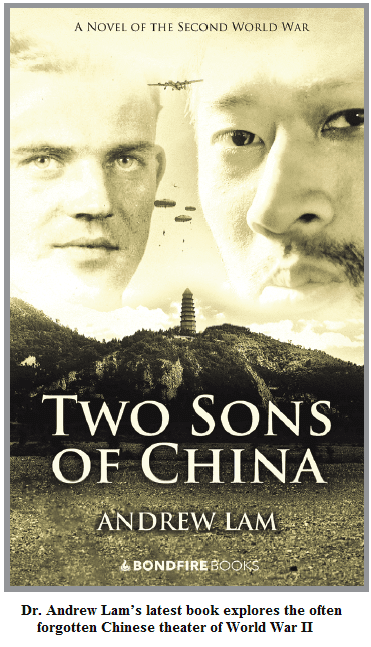Volume Businesses – Noted Eye Surgeon Andrew Lam Shows He Has the Write Stuff
China 1944: American lieutenant David Parker and Communist guerilla Lin Yuen have nothing in common except a common enemy — the Japanese. When fate brings them together for a dangerous assignment behind enemy lines, their clashing convictions threaten to derail the mission. But the battles they fight, the horrors they witness, and the brotherhood they forge ultimately transform them both.
That’s a passage off the book jacket of Two Sons of China, a novel penned by noted retinal surgeon Dr. Andrew Lam. The language is typical of that used by publishers to compel readers to turn some pages and buy the book, and it explains what this historical novel is all about.
But that excerpt doesn’t begin to convey the passion that Lam has for history, military history, World War II, and especially the usually forgotten theater of that global conflict — the war in China.
“I wrote this because I wanted more people to know what happened in China during World War II,” said Lam, who studied history as an undergraduate at Yale but was ultimately swayed to enter the medical field by the seemingly countless stories of the life-saving exploits of his father, a cardiologist (more on those later). “A lot of people don’t know that thousands of Americans served in China during the war and that millions of Chinese died; China actually served a very important role in the Allied victory, yet few seem to know the story.”
Telling it, or at least part of it, through this saga based on true events has become the latest chapter in an intriguing and newsmaking career, one that has put Lam’s name together in the same sentence with the phrases ‘distinguished ophthalmologist’ and ‘bestselling and award-winning author.’
Those latter honors were earned with his first published work, Saving Sight, subtitled An eye surgeon’s look at life behind the mask and the heroes who changed the way we see. It’s mostly about science and developments such as refractive surgery and treatment of wet macular degeneration, but there is also a lot of history, such as in the stories about Louis Braille and his language for the blind and Harold Ridley’s invention of the intraocular lens and how it took nearly 30 years to come into use.
And they’re told with heavy use of the first person, which gives such weighty subjects and 15-letter words a needed personal touch.
“I told my agent I wanted to write a book about the heroes of ophthalmology,” he recalled. “And she said, ‘that’s fine, but nobody’s ever going to buy that book, because only nerdy ophthalmologists would buy a book about medical non-fiction like this.’ So I decided I had to do something to make it more marketable, to make it more interesting, to make people want to pick up a book about medical history.”
That something turned out to be his decision to blend his own experiences training in surgery, a tactic that helped the book, which came out nearly a year ago, greatly exceed his publisher’s expectations, become a bestseller on Amazon, and earn awards from the London Book Festival and the New England Book Festival, with more competitions to come.
Two Sons of China was actually finished before Saving Sight, but it took Lam’s agent more time to find a publisher for that work. The novel was released in December, and early sales have been promising.
Meanwhile, Lam is hard at work on his next project, a detailed look at the famous 442nd Regimental Combat Team — the unit of Japanese-American soldiers that fought in Europe during World War II while many of their families were held in internment camps in the U.S.
For this issue, HCN talked at length with Lam about his twin passions, and how they both might be considered volume businesses.

Novel Ideas
The lobby at New England Retina Consultants looks like most other medical waiting rooms, with rows of seats, assorted magazines on a table near the front, and staff members taking information and calling out patients’ names.
What sets it apart are all the framed newspaper clippings about Lam and his books and signs alerting visitors that signed copies of these works are available for purchase.
The juxtaposition of these items speaks to how effectively Lam has been able to blend his passions for medicine and history rather than choose one over the other.
How he’s managed to do that is an intriguing story, one that begins in Springfield, Ill., where Lam grew up and received almost daily reminders about how respected, and revered, his father was in that community, famous as the birthplace of Abraham Lincoln.
“I’d go to the mall or just walk around the city, and people would stop me and say, ‘your dad’s a great doctor; he saved my life or the life of a loved one — are you going to be a great doctor like your dad?’” he recalled. “These kinds of experiences left an indelible mark on me; they showed me that being a physician could be a very gratifying thing. He had a very gratifying career, and you can’t help but be influenced by that when you’re growing up.”
So strong was that influence that Lam put aside any thought of doing graduate work in history and instead went to the University of Pennsylvania Medical School, where he quickly focused on surgery, which fit his personality — “I like to fix things; I like to do things and see if I can make things better” — and the eye.
“I felt that sight is so important to everybody, so ophthalmology was the perfect fit,” he said, adding that, 10 years after graduating from Yale, he completed a fellowship at the prestigious Wills Eye Hospital in Philadelphia and then joined New England Retina Consultants in Springfield, where he saves patients’ sight on a daily basis.
He treats a number of conditions, including retinal detachment, macular degeneration, and diabetic retinopathy, and told HCN that the work is extremely rewarding because of the seriousness of those problems and the ability to greatly improve quality of life by providing solutions.
“The people I treat have serious eye problems — if other eye doctors have a complication, they will often call on us to help them,” he said. “But the flip side to this is that it’s very gratifying to try to help people, because we’re talking about their vision.”
But while Lam was certainly excelling in his chosen field, his passion for military history — and, more specifically, U.S. involvement in Asia during various 20th-century conflicts — never left him, and he began looking for ways to express it. He found one in his desire to relate a little-known chapter from the forgotten Chinese theater of World War II — an operation known as the Dixie Mission.
This was the first effort on the part of the U.S. to establish official relations with the Communist party of China and the People’s Liberation Army, led by Mao Zedong, which was then headquartered in the mountainous city of Yenan.
“During the war, Americans supported Chiang Kai-Shek’s nationalist government in Chungking,” he explained while turning to a map in his book. “But he wasn’t the best ally because his government was very corrupt and inept, and they weren’t really interested in fighting the Japanese — they wanted to hoard American weapons so they could use them in the future civil war with the Communists.
“So the Americans were very frustrated because they wanted to fight the Japanese,” he went on. “They later learned about another group of Chinese in the north in Yenan. It turned out that these were Mao’s Communists, and at this point we had no idea they would be the future leaders of China; these were just agrarian reformers who were also fighting the Japanese even though they hated the Nationalists, and there was basically a separation.”
The name Dixie Mission stemmed from how Americans viewed the Communists as rebels, not unlike Southerners during America’s Civil War, said Lam, adding that U.S. forces joined the Communist guerrillas on a mission behind Japanese lines. Accounts of this mission provided inspiration for the book, but Lam chose fiction to make the subject more entertaining for the reader.
“My goal is help people learn about the war in China,” he explained, “but I thought personally that it would be fun to write an exciting, action-packed, emotional war novel that would entertain people.”

The Latest Word
While his agent was shopping Two Sons of China, Lam shifted his focus — both literally and figuratively — to a different kind of hero: pioneers in eye care.
He said Saving Sight was inspired by the groundbreaking developments in ophthalmology and a desire to retrace some of the steps that laid the groundwork for these advances.
“We can take out cataracts in minutes, we can do Lasik surgery, which yields instant, glasses-free 20/20 vision, and we’re even starting to implant retinal microchips that can return some sight to the blind — it’s FDA-approved, but we haven’t started doing it yet,” he explained. “These are amazing things that we do, and I started thinking, ‘how did all this come about — who invented them?’
“What I learned were these stories of the heroes of my field,” he continued. “And these are incredible stories — they have the components of a Hollywood movie; there’s perseverance, serendipity … a lot of these people were ridiculed for their ideas for decades before they came into acceptance. I knew I wanted to write a book that shared all that.”
And Saving Sight is something quite unique in literature, he went on, adding that no one in the profession had written a memoir on what it’s like to be an eye surgeon, and it’s clear from the first year’s sales volume that the market was ready for one.
But as he tapped on the cover of Two Sons of China, Lam noted that fiction in general, and even historical fiction, is something much different.
“There’s a lot of competition in fiction,” he said, adding that, to stand out, a work of historical fiction must both inform and entertain. He believes Two Sons of China achieves that mission, and that his latest project involving the 442nd, called Repentance, will follow suit.
“Asian Americans know about the 442nd; it’s famous for us,” he told HCN. “But not enough Americans know about it. This is the most decorated unit in U.S. military history — they won more than 20 Medals of Honor.”
As he continued to talk about the 442nd, the war, and the contributions of countries such as China and Russia, Lam’s passion for the subject came through loud and clear. And it is that passion that drives him to write — and find the time to do it.
“My goal is basically to inspire people,” he said. “I hope Saving Sight inspires young people, and I hope Two Sons of China helps people understand the history of World War II more, and you only do it because you’re passionate about it — it’s too much work otherwise.”
He said people are always asking where he finds the time for his writing, and admits that he has no profound answer for them other than to say that, if one is passionate about something — and he is when it comes to both science and history — then he or she finds the time.
“I have a great wife who supports me,” he noted. “I write whenever I can, like if I’m driving my kids and waiting for them after gymnastics, or if I’m waiting poolside at my son’s swim meets. There was a time when I’d watch a movie every night, but that was a major time suck, and I stopped doing that; now I use that time to write.”
Epilogue
Speaking of films, Lam said his agent is already having discussions with at least two parties interested in the movie rights to Two Sons of China.
Those talks are still in the preliminary stages, and he considers it unlikely that the story will be coming to the big screen anytime soon, although he’s staying optimistic.
“It’s a long shot, always, but there is interest,” he told HCN, adding that he’s not sure how that story will end.
He is sure that he will have more stories to share. That’s because his passion for history is deep, and while it’s not his career, it’s a big part of his life, and it always will be.





Comments are closed.